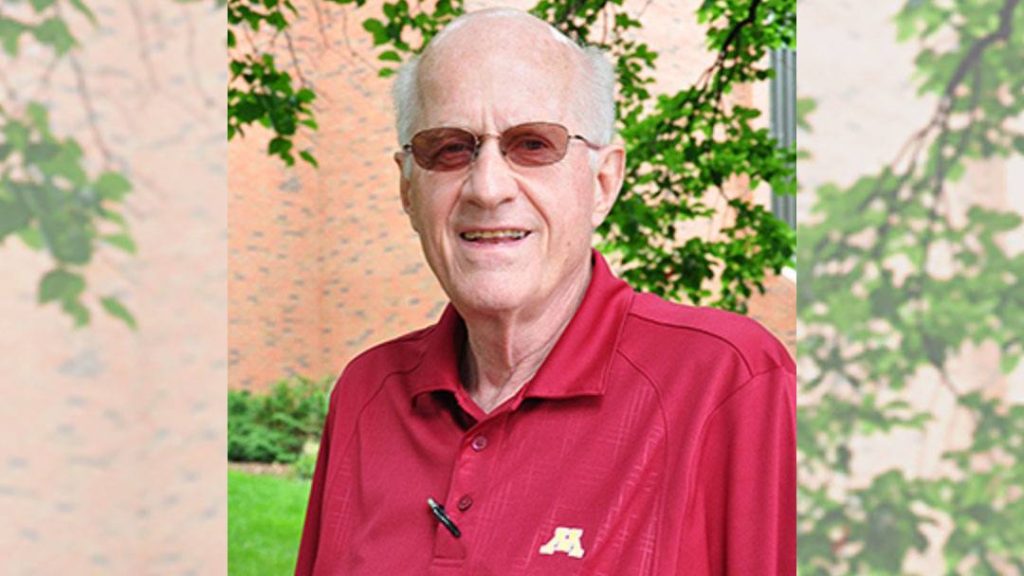
Gyles Randall lived for years with pervasive pain that radiated down his legs. When he no longer could tolerate the discomfort, he sought medical help and was surprised to be referred to a neurosurgeon. But that referral made a world of difference.
As an agriculture researcher focused on soil fertility, nutrient management and tillage, Gyles Randall was used to being outdoors and active. Now retired, the former faculty member at the University of Minnesota holds a doctorate in soil science, and for decades, Gyles' work took him into farm fields throughout southern Minnesota.
So when Gyles started experiencing leg and back pain, it might have been easy to blame his years in the field as the culprit. But that wasn't the case. In fact, he felt better when he was moving. "When I was sitting at the desk in the office, the pain was worse than when I was standing or walking or working in the fields," Gyles says.
The pain turned out to be a result of wear and tear on his spine that had developed gradually. Now after two spine surgeries over the span of several years, Gyles is free to enjoy his active ways once again.
Stubborn pain
The problem started more than 10 years ago when pain began to radiate throughout Gyles' waist, buttocks, legs, calves and ankles. He put up with the discomfort until he couldn't ignore it any longer. Randall had his condition evaluated, and he was surprised to be referred to a neurosurgeon who recommended spinal fusion surgery.
Several days after his retirement, Randall underwent a procedure to fuse two vertebrae in the middle of the lumbar portion of his spine. Located in the lower section of the spine, the lumbar region helps support the weight of the torso.
Gyles' surgery was a success — for a while. "I was pain-free for five years," he says. "Then in 2016, I started noticing some pain again that got worse and worse through time."
"You live with it, and pretty soon it gets to the point where life isn't quite as enjoyable when you're in pain."
Gyles Randall
As with his previous bout of pain, Gyles let it go longer than he should have. "You live with it, and pretty soon it gets to the point where life isn't quite as enjoyable when you're in pain," he says. "Your body has a way of adjusting for it; you bend or lean over. If you're walking in a setting where other people know you, and you're starting to hunch over, they ask: 'Aren't you doing well? Aren't you feeling well?'"
Gyles wasn't doing well. In addition to the pain radiating downward, it also began affecting the upper portion of his spine. Although the problem originated in his lumbar region, Gyles was feeling the effect from his ankles all the way up to his neck. He received cortisone shots to ease the discomfort, but their effectiveness began to wane over time.
Healthy again
When the cortisone shots stopped working in 2018, Gyles knew he needed another surgery. At that time, Mayo Clinic Health System in Mankato, Minnesota, was expanding its Spine and Neurological Surgery practice by adding two neurosurgeons, Meghan Murphy, M.D., and Anthony Burrows, M.D. When he learned about that, Gyles made an appointment.
"Soon after the surgery, I was standing up straight, my posture was excellent, and I was feeling like a new person."
Gyles Randall
In December 2018, Dr. Murphy performed Gyles' second surgery. It involved lumbar decompression and fusion of four lumbar discs. After the surgery, Gyles had physical therapy in his hometown at Mayo Clinic Health System in Waseca, Minnesota. Since then, the improvement has been significant.
"I was very pleased," Gyles says. "Soon after the surgery, I was standing up straight, my posture was excellent, and I was feeling like a new person."
Several months after the procedure, Gyles still had some stiffness in his back. But the debilitating pain was gone, and he had returned to a much more active lifestyle.
"It's not quite as easy to tie my shoes, but I'm walking rather fast and gaining strength, too," he says. "I'd like to give Dr. Murphy and her team all the credit, as their surgical skills converted me from a hunched-over person full of pain to a very healthy feeling person without pain like I remember when I was in my 50s."
Note: A version of this story previously was published in Hometown Health.
HELPFUL LINKS
- Learn more about spinal fusion surgery.
- Read about Spine and Neurological Surgery.
- Connect with others talking about spine care on Mayo Clinic Connect.
- Explore Mayo Clinic Health System.
- Request an appointment.







